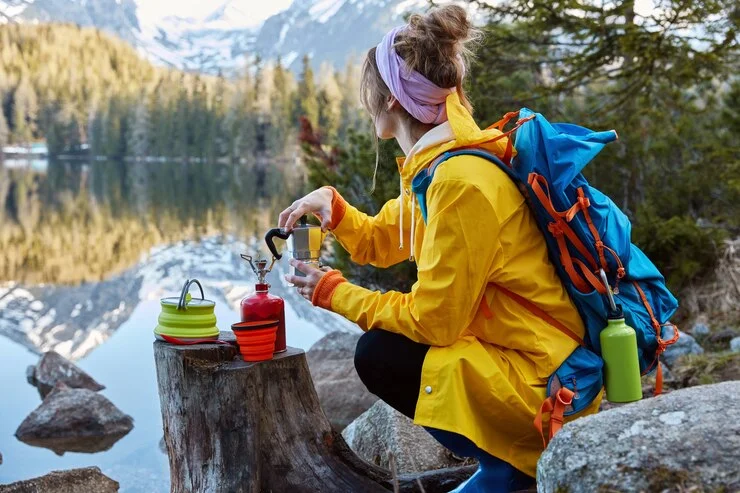Hiking is one of the best recreational activities that allows one to have fun, exercise, and appreciate nature. Whether it is hiking for beginners, it is crucial to adhere to the that are best hiking practices. This extensive resource offers general hiking information, including hiking preparation, hiking tips, safety advice, essential hiking gear, and protection of the environment. Now, let’s take a look at the hiking essentials that every hiker should consider.
Preparing for Your Hike: Key Considerations
It is very important to have a good plan in place before going for any hiking trip. Preparation minimises the chances of hikers getting stuck on the trail and not able to handle whatever comes their way.
Plan Your Route Carefully
One of the most important suggestions for beginner hiking tips is to plan the hiking route beforehand. For hiking beginners, it is recommended to find a trail that will fit their fitness level.
Check the Weather Before You Go
Check the weather before going on any hiking trip. Hiking in all weather conditions is fun, but it always calls for preparation. Weather can also hinder extreme heat or cold, rain or snow and affect the safety of trails.
Build Your Fitness for Hiking
Fitness is an important factor that determines how much fun and how effective hiking will be. Those who are new to hiking should warm up by hiking less active trails or short ones and then increasing the level of difficulty over time.

Essential Hiking Gear
Selecting appropriate hiking gear is a very vital aspect in determining the outcome of the hiking exercise. A proper hiking checklist makes sure that hikers meet every situation in the right manner with all the equipment needed in place.
Wear the Right Footwear
In deciding what the best hiking boots for trails are, then one must look for strong, stable and appropriate shoes. Shoes are one of the most essential hiking gears since they contribute to comfort and stability. For rough terrains, proper hiking shoes with high ankle support would be appropriate, while for moderate terrains light hiking shoes or trail running shoes may suffice.
Dress in Layers
It is useful to wear several layers of clothes in order to regulate the level of heat in the body during the hike. Proper dressing for hiking in all weather conditions can be useful within avoiding hypothermia or heat problems.
Backpack Essentials
A good pack is essential for a safe and fun hike; it is essential that it is packed correctly. These are some hiking essentials to pack which water and other high energy foods, map, compass or GPS, first aid kit, flashlight, extra clothes, multi-tool. Knowing what to pack for a hike means that hikers can handle any emergency or change in weather conditions on the hike.
Hiking Poles: Are They Necessary?
Hiking poles can be used for additional support and push on the knee during ascending or descending of hills. Even though they are not a necessity in every hike, they can be helpful especially for those with arthritis or when dealing with steep trails.
Safety Tips for a Successful Hike
It is always important to ensure safety during any occasion that will involve going out doors. Adhering to these safety tips for hiking can assist in avoiding mishaps and ensure the trip is fun.
Stay Hydrated and Well-Fed
There is information about the importance of taking enough water and other foods to help the body to produce enough energy. Hikers should always have water with them and should drink it frequently irrespective of the level of dryness of their throat. Carrying electrolyte drinks can go a long way to replenish the lost electrolyte in the body through sweat.
Know Your Limits
Among the most important hiking safety advice tips, one has to understand that he or she has personal limitations. One can even end up getting too exhausted or even get injured or even involve in an accident if one goes beyond his or her ability.
Navigating the Trail Safely
Navigation is a crucial aspect of hiking safety. Carrying a map, compass or a GPS can help hikers not to get lost. Similarly, it is advisable to avoid cutting corners and stick to the established tracks and paths.

Environmental Responsibility While Hiking
Locally, it is the responsibility of any hiker to ensure that he or she does not harm the environment in anyway. Other key aspects of hiking that is majorly encompassed in hiking include; Respecting the outdoors and practising the seven Leave No Trace hiking principles and supporting conservation.
Leave No Trace Principles
Leave No Trace principles are based on the notion that people should cause minimal impact on the environment. This hiking helps to preserve the physical assets of a country in as natural state as they were before the hiking expeditions.
Respect Wildlife and Plants
Wildlife is always exciting to meet, but one must avoid approaching the animals and interfering with their behaviour. It is dangerous to feed wild animals because it may lead to dependency on human foods.
Support Local Conservation Efforts
Supporting or contributing to local conservation efforts can ensure the protection of the natural landscapes where people exercise in the trails. Local people support trails maintenance, habitat and wildlife conservation and rehabilitation projects. Local conservation efforts are crucial to prolonging the existence of natural hiking sites hence the support.
Hiking Etiquette: Sharing the Trail
Good trail etiquette for hikers is important in making sure a positive experience. Respecting other hikers, wildlife, and the environment is a measure of being a responsible person who loves the outdoors.
Be Respectful of Other Hikers
As with any trial user, there are specific rules that have to be followed to give way to the other party. For those hiking with pets, it is advisable to ensure that the dog is restrained both by means of a leash and his owner’s control so as to prevent any incidents with the other hikers.
Keep Noise Levels Down
One of the most obvious and basic forms of recreation is to have the ability to enjoy the serenity of nature while hiking. Low noise further helps other people enjoy the quiet environment and elevates the chances of witnessing wild animals.
Hiking with Pets
It is fun to take pets on a hike, but it is more complicated. People with pets should ensure that the trail allows the dog to follow the leash law. Adhering to hiking with pets tips, like picking after their pets and avoiding contact with wildlife, makes the outing enjoyable for all parties.
How to Prepare for a Hike
It is always advisable for a beginner in the hiking business to prepare adequately for any hiking trip. Understanding how to prepare for a hike goes beyond packing for the activity and requires some understanding. Some of the preparations are exercise before the hike, selecting the right trail for the hiker, and the minimum map reading skills required on the trail.
Additional Safety Considerations
Besides the list of what to pack for a hike and a first aid kit, hikers should acquaint themselves with basic first aid. It is always important to know how to treat blisters, minor cuts or insect bites so as to avert a small incident into a major one.
Trail Etiquette for Hikers: Sharing the Experience
It is, therefore, important that good trail etiquette is followed by all the participants in a trail. Some of these are giving way to horseback riders and cyclists whenever necessary, and where the trail is wide, moving to the right for other hikers. It is good practice when hiking with pets to ensure they are restrained to avoid inconveniencing other hikers or reacting to wildlife.
Supporting Local Communities and Conservation Efforts
Besides helping the economy, when one contributes to the local community where one hikes, one helps conserve natural resources. Hikers can avoid environmentally adverse consequences by sticking to the Leave No Trace principles they familiarised themselves with.
What to Pack for a Hike: Creating a Comprehensive Checklist
Preparing a hiking checklist helps ensure that important items are included. In addition to water, food and maps for navigation, it is advisable to pack clothes for a change in weather, a hat against the sun and a small tarp against other eventualities. Packing essential hiking gear needed for a hike systematically guarantees that all that is important is included while at the same time not overloading the backpack with unnecessary items. Consulting hiking gear recommendations before embarking on a trip. This way, they are well-equipped for varying terrains and even weather changes.
Conclusion
Hiking is an exciting outdoor adventure that is very beneficial to the body and the mind. Regardless of how often one goes hiking, it is always important to follow essential hiking tips that will help to make the experience safer and more enjoyable. From careful hiking preparation and essential hiking gear, basic safety and ecological precautions are also the constituents of a successful hike.
Newcomers can increase their knowledge about how to prepare for a hike, while experienced hikers can improve their practises with new hiking safety advice and recommendations. Finally, understanding trail etiquette for hikers and being considerate of nature allows everybody to hike for many more years.







